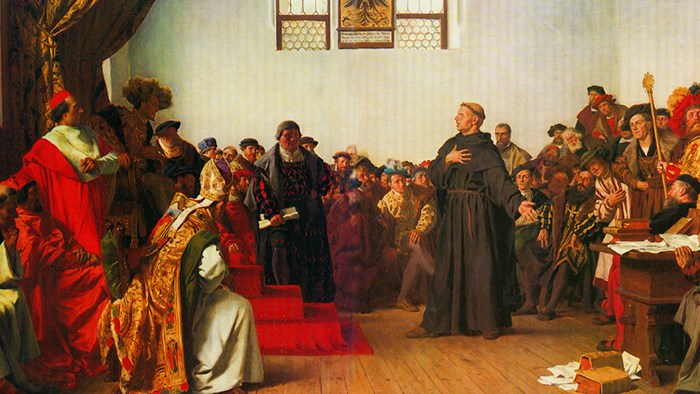For by grace you have been saved through faith. And this is not your own doing; it is the gift of God, not a result of works, so that no one may boast.
Ephesians 2:8-9
(emphasis added)
"Here I Stand."
(attributed to Dr. Luther at the Diet of Worms, 1521)
Five hundred years ago, today, an Augustinian monk serving as a professor of theology at an up-and-coming university started a conversation.
That man was Martin Luther. The conversation was, initially, regarding indulgences and other relatively minor grievances he noted, but soon grew into a struggle to (for lack of a more evocative term at the moment) "fix" the church.
In a way, Luther was getting back to his roots. His father was in the metalworking industry, specifically the mining of copper. Martin, though, was a metaphorical blacksmith. He took the material on hand, which he noted contained some flaws and impurities, and sought to refine them out. He looked to reform the defiled billet of steal so it could be a sword again. Luther never intended to throw out and start over, and he and those who followed did no such thing.
The more Luther learned his craft (theology) and the more he examined the Roman church and society in Europe, the more he was compelled to push for this discussion of getting back to the roots. Ad fontes - to the sources.
From a certain point of view, the issue wasn't that the Church did not exist in 1517, but that it had been hidden by all sorts of unnecessary burden and gilding that drove the believer away from the saving grace of the Cross. It was as if someone had taken a simple sword and covered the blade with gold plating and gemstones, then painted all that over, then covered it in stucco, then smeared with silly putty. The implement was no longer useable, or even recognizable. Luther and the Reformers wanted to clean away all the burdensome additions. Not all additions were bad (sometimes we call these things adiaphora, though the term is more complex than that).
At the heart of the Reformation, the real Reformation (not the radical revisionism happening in Switzerland, Holland, and elsewhere), was one thing:
Jesus Christ
They didn't want to get rid of all traditions, or remove all authority, or tear down cathedrals, or forget the saints, or rely on reason/emotion/tradition/logic/science/authority/works to base their movement on. The Reformers could be called minimalists, throwing off the unneeded without loosing what was required.
In some ways, it is similar to a practice done by pilots in World War 2. Now, bear with my metaphor for a moment, 'cause it won't seem to be congruous. If you saw the movie Pearl Harbor, my condolences. But recall the ending, where they have the Doolittle Raid. The crews are preparing the B-25 bombers for the mission, which includes flying farther than their safe effective range and launching from an aircraft carrier. In the one scene the pilots are removing anything they don't need. The bombsights were replaced with a much lighter one. Extra guns were removed. Even armor plate was dropped, with one mechanic saying "loose it like a skirt, son."
Now, I'm making light of a serious topic (two, technically), but hopefully you see my point. More and more had been "tacked on" to the Church until she was unrecognizable. Luther, thanks to his vantage point on the inside, and his deep need for reconciliation with God, started digging and worked his way to the most distilled version. That's the intent of the Reformation: getting back to the roots of the faith. And the roots of our faith is the Cross and Empty Tomb.
So, raise a pint of your favorite stout, ale, or Fanta, for Martin Luther, a conservationist interesting in restoring that which was misled.
(Dear internet, why don't you have more versions with these lyrics?)

No comments:
Post a Comment